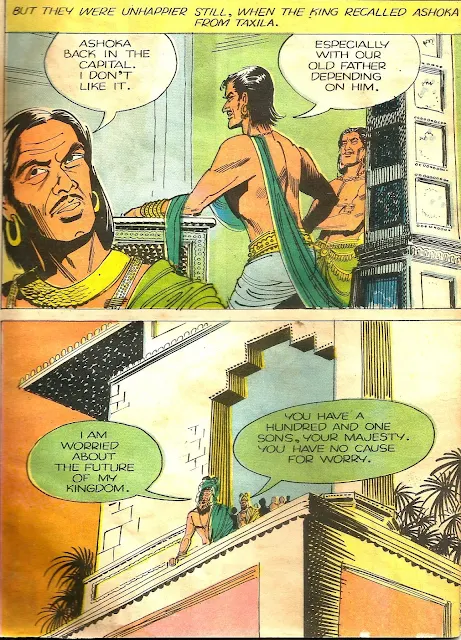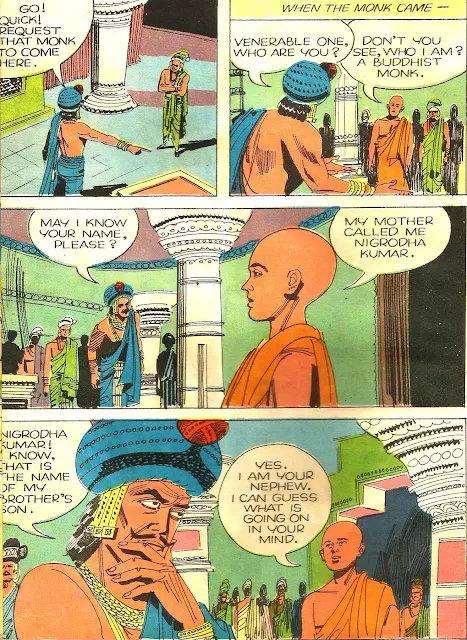 |
| Ashoka The Great (Graphic Story) |
King Ashoka:
 |
| A Chakravartin ruler, first century BC or CE, Andhra Pradesh, Amaravati,Preserved at Musee Guimet. |
Ashoka ( 304–232 BC), also known as Ashoka the Great, was an Indian emperor of the Maurya Dynasty who ruled almost all of the Indian subcontinent from ca. 269 BC to 232 BC. One of India's greatest emperors, Ashoka reigned over most of present-day India after a number of military conquests.
 |
| Maurya Empire at the age of Ashoka. The empire stretched from Afghanistan to Bangladesh or Assam and from Central Asia (Afghanistan) to Tamil Nadu,South India. |
His empire stretched from the Hindu Kush mountains in Afghanistan to the present-day Bangladesh and the Indian state of Assam in the east, and as far south as northern Kerala and Andhra Pradesh. He conquered the kingdom named Kalinga, which none of his ancestors had conquered starting from Chandragupta Maurya. His reign was headquartered in Magadha (present-day Bihar).
He embraced Buddhism after witnessing the mass deaths of the Kalinga War, which he himself had waged out of a desire for conquest. He was later dedicated to the propagation of Buddhism across Asia and established monuments marking several significant sites in the life of Gautama Buddha. Ashoka was a devotee of ahimsa (nonviolence), love, truth, tolerance and vegetarianism. Ashoka is remembered in history as a philanthropic administrator.
 |
| Sanchi-Stupa |
The source of much of our knowledge of Ashoka is the many inscriptions he had carved on pillars and rocks throughout the empire. All his inscriptions have the imperial touch and show compassionate loving. He addressed his people as his "children".
 |
| Ashoka's First Rock inscription at Girnar |
These inscriptions promoted Buddhist morality and encouraged nonviolence and adherence to Dharma (duty or proper behavior), and they talk of his fame and conquered lands as well as the neighboring kingdoms holding up his might. One also gets some primary information about the Kalinga War and Ashoka's allies plus some useful knowledge on the civil administration.
 |
| 3D Picture of Ashoka Pillar Made by Me (Manash Kundu) |
The Ashoka Pillar at Sarnath is the most popular of the relics left by Ashoka. Made of sandstone, this pillar records the visit of the emperor to Sarnath, in the 3rd century BC. It has a four-lion capital (four lions standing back to back) which was adopted as the emblem of the modern Indian republic.
 |
| 3D Picture of Ashoka Stambha`s Lions (four lions standing back to back) which was adopted as the emblem of the modern Indian republic. 3D Picture made by me (Manash Kundu) |
The lion symbolizes both Ashoka's imperial rule and the kingship of the Buddha. In translating these monuments, historians learn the bulk of what is assumed to have been true fact of the Mauryan Empire. It is difficult to determine whether or not some actual events ever happened, but the stone etchings clearly depict how Ashoka wanted to be thought of and remembered.
History chronicles innumerable kings who were brave conquerors and valiant soldiers. But Ashoka stands above them all because he is the only one who at the zenith of his conquests saw the futility of violence and had the courage to renounce it. That is way , H.G.Wells in his "Short History of the World" says that Ashoka`s " reign for eight and twenty years was one of the brightest interludes in the troubled history of mankind." Wells goes on to say, " Such was Ashoka, the greatest of kings. He was far in advance of his age."
This Pictorial story is based on the original research of the author into Mahavamsa, Dipavamsa, commentary on Mahavamsa, and the edicts of Ashoka. Pali Manuscripts and other secondary sources have also been extensively studied in gleaning facts which should Kindle a new interest in Ashoka.
 |
| 3D Picture of Ashoka Stambha`s Lions (four
lions standing back to back) which was adopted as the emblem of the
modern Indian republic. 3D Picture made by me (Manash Kundu) |






















































 Online Movies
Online Movies
No comments:
Post a Comment